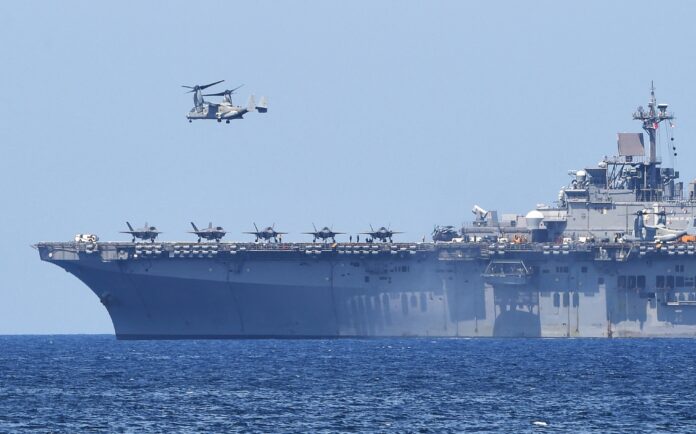Chinese state media said an upcoming naval patrol planned by the U.S. and two key allies would further destabilize the region.
According to a Politico exclusive that cited U.S. and foreign officials speaking on the condition of anonymity, American, Japanese, and Philippine naval forces are expected to carry out a joint patrol later this year in the South China Sea—almost all of which China claims sovereignty over.
The Global Times, a state-backed news outlet in China, published an article on March 31 saying Japan’s alliance with the U.S. was “evolving into an axis of evil,” and that the U.S. was “encouraging the Philippines to incite chaos in the South China Sea.”
The report cited a recent statement by Admiral John Aquilino, Commander of the U.S. Indo-Pacific Command, as an example of the U.S.’s encouragement. Aquilino said, “The Philippines, if a sailor or soldier, or one of their members were killed, could invoke Article 5 of the Mutual Defense Treaty.”
The exercise comes as Washington locks arms with Tokyo and Manila—whom it shares defense treaties with—as Beijing acts increasingly forcefully to back its sweeping territorial claims in the region.
News of the patrol follows a flurry of security arrangements ahead of the first trilateral summit on April 11, when President Joe Biden is set to host Japanese Prime Minister Fumio Kishida and Philippine President Ferdinand Marcos Jr. in Washington, D.C.
White House Press Secretary Karine Jean-Pierre said in March the trio would discuss, among other things, cooperation to “further peace and security in the Indo-Pacific.”
“Japan’s decision to join the maneuver is a typical example of the U.S. attempting to recruit more allies in a highly sensitive and conflict-prone area, in order to consume allies’ resources and weaken China,” Li Haidong, a professor at China Foreign Affairs University, told the outlet.
Li added that allies of the United States should be aware “they are all pawns for the U.S. to benefit from.”
Since last year, the Philippine president has been pushing back more assertively against Chinese coast guard and paramilitary activities within the Philippines’ internationally recognized exclusive economic zone.
Ted Aljibe/AFP via Getty Images
The U.S. “often appears to urge its allies to brave dangers, but in reality, it sacrifices them to meet its own selfish strategic demands,” Li continued, citing Ukraine as an example of a country left to “fend for itself” while serving the purpose of weakening a U.S. adversary.
Newsweek contacted the governments of the U.S., Japan and the Philippines for comment by email.
Amid increasing Chinese pressure in the South and East China Seas, the U.S., the Philippines, and Japan have over the past year increased the pace of collaboration in the name of regional security.
In June, the nations held their first trilateral naval drills. Japan also chose the Philippines as the first beneficiary of its new Official Security Assistance program last year and pledged a $4 million coastal radar system to augment the Southeast Asian country’s surveillance capabilities.
During his address to the Philippine legislature in November, a first for a Japanese prime minister, Kishida proposed routine exchanges between the countries’ armed forces.
In April 2023, Manila greenlit plans for four new bases under its Enhanced Defense Cooperation Arrangement with Washington, which allows the U.S. to rotate its troops for extended stays and operate facilities usable by both American and Philippine forces.
In March, reports said the U.S. Army would help construct a seaport on the northernmost Philippine province, near Taiwan and the Miyako Strait, a strategic pinch point that would be key to denying Chinese forces access to the open Pacific in the event of a conflict.
Uncommon Knowledge
Newsweek is committed to challenging conventional wisdom and finding connections in the search for common ground.
Newsweek is committed to challenging conventional wisdom and finding connections in the search for common ground.


